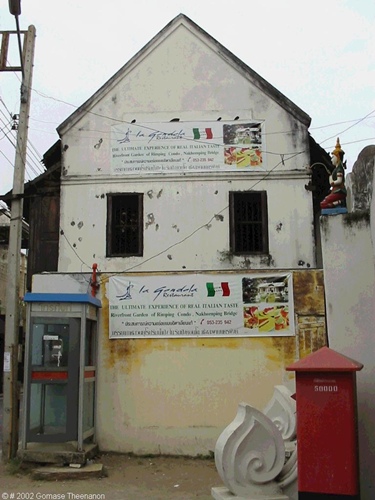|
One day
I had a call from vice-professor Chusit Choochart, a lecturer in history of the
Chiang Mai Rajabhat
University. Archarn
Chusit has written research papers and historical books about the Chinese
immigrants in Chiang Mai. He invited me to join a visual education class of
students of the tourism business program to the old town’s trading area of
Chiang Mai.J
Winds of change are like the flowing
river, but the memories of Wat Gate community, which is located on the Bamrungrat
Road on
the eastside of the River Ping, have not been eroded. Many stories remain in
each building, and they contribute to the complex history of the northern
city’s oldest communities.
Our Sunday morning trip started from
the office of the Tourism Authority of Thailand on Chiang Mai-Lamphun Road.
We strolled
along the riverside footpath, headed north to Nawarat Bridge.
About 100 meters from the Chiang
Mai Christian
School, our guide Prof
Chusit showed me the 100-year-old wooden house and hotel.
This
house belonged to Sri Mo, the first person
to travel from Chiang Mai to the US, 100
years ago. For two
generations, the house was a primary school, then a private zoo, and then the
city’s first printing shop. Later, Sri
Mo’s descendants sold the house
to Luang Sri Prakard, who started the hotel business, the current use of the
building.
Next to the Sri Prakard Hotel, on
the east of Nawarat
Bridge, is Chiang Mai’s
first Christian church, hidden in the shade of trees. “During the Second
World War the Japanese removed the top of the church’s bell tower and installed
and installed an anti-aircraft gun, but surprisingly this building never was
bombed.” Explained Archan Chusit.
The
summer breeze gently blew from the river, a pleasant feeling, and there was
less traffic than usual on the road. We stopped for a rest at a waterside
public park, its green grass spreading along the Ping River.
I noticed most
of the restaurants
along the river featured the impressive architecture of 100-year-old homes as a
selling point. We crossed the road from the Good View restaurant to look at a
big colonial-style villa built by Burmese owners. These days the home has been
converted into a guest house called Le Pong, “The Bridge” in French.
Then
we arrived at the old Wat Gate
community. During the prosperous times of waterway trading between Chiang Mai
and Bangkok,
people from different cultures and religions migrated to Chiang Mai to settle
along the river. These immigrants included Chinese traders, US missionaries,
English logging traders, and Muslims and Sikhs from Panjab province in India.

Some
houses are hidden behind modern buildings. Sometimes we couldn’t see them at
all from the road. “However, it is a good thing the Fine Arts Department has
registered all antique houses of the Wat Gate community as historical
structures,” said Prof Chusit.
The Gallery Restaurant
is one of the
most elegant structures in town. The house was built in 1889 by a Chinese
contractor, and its most beautiful feature is a fine bas-relief at the entrance.
A Lanna-style wooden house lies at the back of the building. It was used as a
warehouse for many years until 1989, when the building underwent massive
renovation to turn it into a restaurant and art gallery.
Our next
stop was Ban Tha Chang,
which means Elephant Pier House, because this house is located close to the
place where elephants used to bathe in the river. Today, the house has been
converted into a riverside restaurant.
The temple along the road
to see
many buildings with exquisite architecture and hearing dramatic stories as we
went, we made the next stop at Wat Gate itself, of everything that is typical
of northern sanctuaries. In the temple grounds is another very old
structure-the old abbot’s residence, which now houses a small Historical
Museum.
It displays antique, everyday items covering the last 100 years, including rare
antiques, old money, fabric and photographs of old Chiang Mai, mostly taken by
missionaries. The museum was founded by Jarin Bain or Uncle Jack, a senior
citizen of mixed Thai-English descent, whose father was the first manager of
British Borneo, the logging company.
After a
long walk around the neighbourhood, our stomachs were ready for food. Archan
Chusit recommended Karim, a Chinese-Muslim restaurant in a small alley leading
to the mosque opposite the Islamic school. “Muslim people are part of the
history, too. They originally came from Pakistan into northern Thailand at the
Burmese border, but then Chinese Muslims also came from Yunnan,” explained
the professor.
From a back street behind the
temple, we again found the main road. We followed the guide to Great
Grandfather’s House, a two-storey teak home that was renovated and now is known
as Regina
guesthouse.
As I strolled along, I noticed many
elegant buildings that are shops selling boutique products and household
accessories. There are also art galleries.
We passed the old fisherman’s
village, and we ended at the old home of Dr Sukit Nimmanhemin. Dr Sukit was
once minister of education and his descendants have preserved his house well. I
thanked Archarn Chusit, who had been such an informative guide. For me, it was
a memorable trip.
Story and photographs by Gomase Theenanon
|

